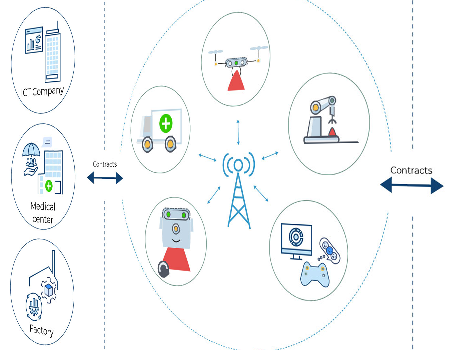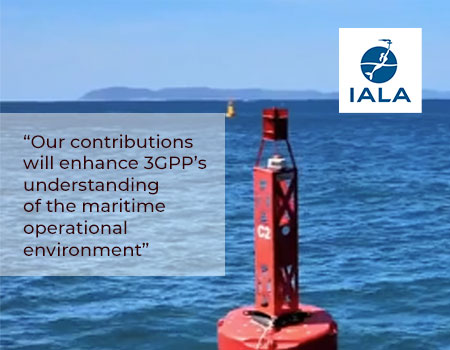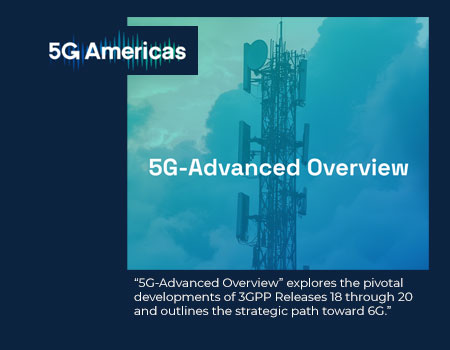By Mirko Cano Soveri,Deepanshu Gautam,Erik Guttman,Hassan Alkanani, Jan Groenendijk, Jean Michel Cornily, Srilakshmi Srinivasaraju, Thomas Tovinger, Yao Yizhi, Xiaobo Yu, Zhang Kai, Zou Lan
The 5G system is expected to be able to provide optimized support for a variety of different communication services, different traffic loads and different end user communities. For example, the communication services using network slicing may include V2X services, 5G seamless eMBB service with FMC and massive IoT connections. A network slice is a logical network that provides specific network capabilities and network characteristics, supporting various service properties for network slice customers.
The management and orchestration of network slices is key to operators in support of their communication services.
This article addresses key technical aspects of network slice management including:
- Concept of network slice management
- SLA requirements
- Performance measurements and KPIs for network slices
- Management Data Analytics for network slices
- Closed loop communication services assurance using network slices
- Management of Non-public networks using network slices
- Management support to network slice security
- Moving forward in Rel-18
Historical highlights
In Rel-15, basic network slice lifecycle management features are supported, including introduction of network slice related concepts, provisioning management, performance monitoring and fault supervision of network slice instances.
In Rel-16, Service Level Agreement (SLA) attributes and the concept of closed loop automation are introduced.
In Rel-17, management of non-public networks realization using network slicing is introduced. The closed loop assurance mechanism is specified to support multiple SLA requirements. More detailed work regarding network slicing related Energy Efficiency (EE) KPIs and SLA enhancement is also included in Rel-17.
In Rel-18, improving the provisioning efficiency with rules and asynchronous operations is currently under discussion. Studies including support to energy utilities service providers, exposure of network slices to customers and intent-driven network slice management are also initiated.
The network slicing related performance measurements and KPIs are enhanced in every release since Rel-16.
Concept of network slice management (TS 28.530)
1. Variety of communication services provided by multiple network slices
The following concepts apply to network slice management:
- Communication services may be supported by one or a combination of network slices
- Network slices are generally composed of network slice subnets (e.g. RAN network slice subnet, Core network slice subnet and Transport network slice subnet)
- Network slice subnets are composed of Network Functions (NF)
- Network functions may be realized via combination of Virtualized Network Functions (VNF) and/or Physical Network Functions (PNF).
A variety of communication services may be provided by one or multiple network slice(s). As an illustration, in the figure below, network slice subnet AN-1 and network slice subnet AN-2 each contain distinct sets of Access Network (AN) NFs. Network slice subnet CN-1, network slice subnet CN-2 and network slice subnet CN-3 each contain distinct sets of Core Network (CN) NFs. The Transport Network (TN) supporting connectivity facilitates the communication between CN and AN NFs.
Network slice subnet A combines network slice subnet AN-1 with network slice subnet CN-1 and corresponding TN connectivity. Network slice subnet B combines network slice subnet AN-2, network slice subnet CN-2 and corresponding TN connectivity. Network slice subnet C combines network slice subnet AN-2 with network slice subnet CN-3 and corresponding TN connectivity. The network slice subnet AN-2 is shared between network slice subnet B and network slice subnet C, while network slice subnet AN-1 is dedicated to network slice subnet A.
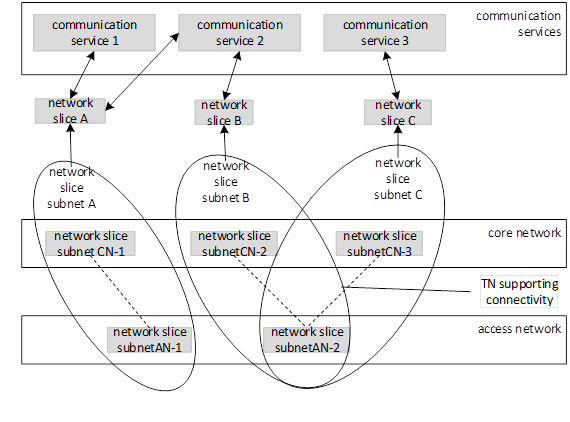
Figure 1 A variety of communication services provided by multiple network slices
2. Roles related to network slice management
- Communication Service Customer (CSC): Uses communication services.
- Communication Service Provider (CSP): Provides communication services. Designs, builds and operates its communication services. The CSP provided communication service can be built with or without network slice.
- Network Operator (NOP): Designs, builds and operates networks and provides related services, including network services and network slices.
- Network Equipment Provider (NEP): Supplies network equipment to network. For sake of simplicity, VNF Supplier is considered here as a type of Network Equipment Provider. This can be provided also in the form of one or more appropriate VNF(s).
- Virtualization Infrastructure Service Provider (VISP): Provides virtualized infrastructure services. Designs, builds and operates its virtualization infrastructure(s). Virtualization Infrastructure Service Providers may also offer their virtualized infrastructure services to other types of customers including to Communication Service Providers directly, i.e. without going through the Network Operator.
- Data Centre Service Provider (DCSP): Provides data centre services. Designs, builds and operates its data centres.
- NFVI Supplier: Supplies network function virtualization infrastructure to its customers.
- Hardware Supplier: Supplies hardware.
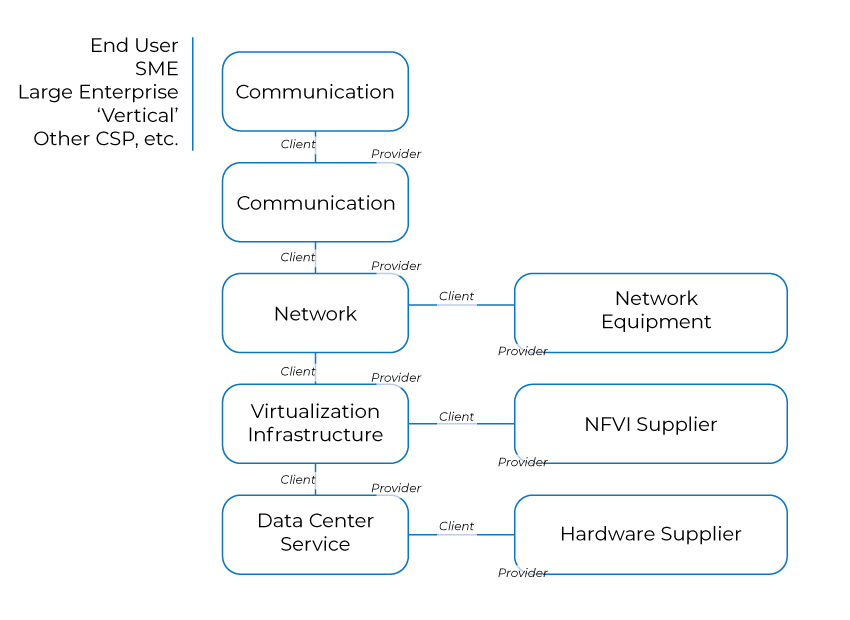
Figure 2: High-level model of roles
3. Usage scenarios of network slice
Network Slice as a Service (NSaaS): Network Slice as a Service (NSaaS) can be offered by a CSP to its CSC in the form of a service. This service allows CSC to use the network slice as the end user or optionally allows CSC to manage the network slice as manager via management interface exposed by the CSP. In turn, these CSC can play the role of CSP and offer their own services (e.g. communication services) on top of the network slice obtained from the CSP. In case of Network Slice-as-a-Service (NSaaS), the customer (taking the role of Network Slice Customer (NSC)) may express requirements towards the Network Slice Provider (NSP) regarding the expected properties of the requested network slice. Such requirements are captured in the ServiceProfile parameter (for requirements against a network slice) and in the SliceProfile parameter (for requirements against a network slice subnet) (see TS 28.541). Examples of such requirements include e.g. required bandwidth, required coverage, etc., derived from GSMA NG.116 attributes.
Network slices as NOP internals: In the "network slices as NOP internals" model, network slices are not part of the NOP service offering and hence are not visible to its customers. However, the NOP, to provide support to communication services, may decide to deploy network slices, e.g. for internal network optimization purposes. This model allows CSC to use the network as the end user or optionally allows CSC to monitor the service status.
4. Management phases in network slice lifecycle
Network slices deployed in operators’ networks have to be managed during their whole lifecycle. A typical network slice lifecycle includes the following phases:
- Preparation
- Commissioning
- Operation
- Decommissioning
Figure 3: Management aspects of network slicing
Use cases and potential solutions for network slice exposure are studied in Rel-18 to enable network slice customers (e.g. from Verticals) to have some visibility, during the Operation phase, on the network slice(s) allocated to them by the network operator. The potential of using Common API Framework for 3GPP Northbound APIs (CAPIF)(see TS 23.222), combined with access control mechanisms, are investigated in TR 28.824.
SLA requirements (TS 28.541)
GSMA has developed the GST (Generic Slice Template) concept. The purpose of GST is to provide the standardized list of attributes that can characterize a type of network slice. Network slicing is a key feature of 5G networks and enables to build dedicated logical networks on a shared infrastructure. These dedicated networks would permit the implementation of tailor-made functionality and network operation specific to the needs of each slice customer, rather than a one-size-fits-all approach as witnessed in the current and previous mobile generations, which would not be economically viable.
3GPP SA5 specifications (e.g. TS 28.541) have adopted the concept of GST and have discussed the mechanism to use GST in Slice Management. The GSMA GST is used as the SLA information for the communication between the vertical industry and the communication service provider. The SLA requirements can be fulfilled from management aspect and control aspect in a coordinated way. The Service Level Specification (SLS) includes ServiceProfile information model.
As shown in the figure below the GST is translated and used as input to ServiceProfile, and the ServiceProfile can be translated to corresponding requirements for dedicated domains. For example, CN SliceProfile is used to carry Core network domain requirements or RAN SliceProfile is used to carry RAN domain requirements. TN related requirements are translated and provide to transport domain. Some of the information in CN SliceProfile is sent to the core network function for the control plane SLA support purpose.
Figure 4: Relation between GSMA GST, ServiceProfile and SliceProfile
Performance measurements and KPIs for network slice (TS 28.552 / 28.554)
The performance of network slicing is monitored and evaluated at 3 levels – the network function/entity level, network slice subnet level and network slice level.
For network function/entity level, the performance of the network functions and entities are monitored in terms of how well they support a specific network slice in the 5GS. The performance measurements are defined for the network functions and entities (including 5GC NFs and NG-RAN network entities) with sub-counter for each network slice (identified by SNSSAI) for this purpose in TS 28.552. Moreover, the performance measurements are further broken down to QoS flow level with the sub-counters for each 5QI.
The performance for network slice subnet level and network slice level are evaluated by the KPIs as specified in TS 28.554.
The KPIs for network slice subnet are consolidated and calculated based on the performance measurements of the constituent network functions and entities.
The KPIs for network slice are calculated based on the performance measurements of the supporting network functions and entities (i.e., the network functions and entities supporting the monitored network slice).
The performance measurements and KPIs for monitoring and evaluating the performance of network slicing at network function/entity level, network slice subnet level and network slice level are defined since Rel-15, and continuously enhanced in every higher release (till Rel-18 undertaken by an ongoing work item).
Energy Efficiency (EE) for network slice, during the operation phase of network slices, Energy Efficiency KPIs may be collected. EE KPIs for network slices are defined as the ratio between the performance of the network slice and its energy consumption, where the performance is defined per type of network slice and the energy consumption is calculated based on the energy consumed by constituent network functions. In Release 17, EE KPIs have been defined for eMBB, URLLC and MIoT network slices in TS 28.554.
Management Data Analytics (MDA) for network slice (TS 28.104)
The MDA, as specified in TS 28.104, is an OAM capability that enables the production of analytics output based on a set of analytics input data. The MDA supports a wide range of analytics capabilities/use cases, including some related to network slicing.
- A Management Data Analytics Function (MDAF) may play the roles of MDA Management Service (MnS) (a.k.a. MDAS) producer, MDA MnS consumer, other MnS consumer, NWDAF consumer and LMF service consumer, and may also interact with other non-3GPP management systems.
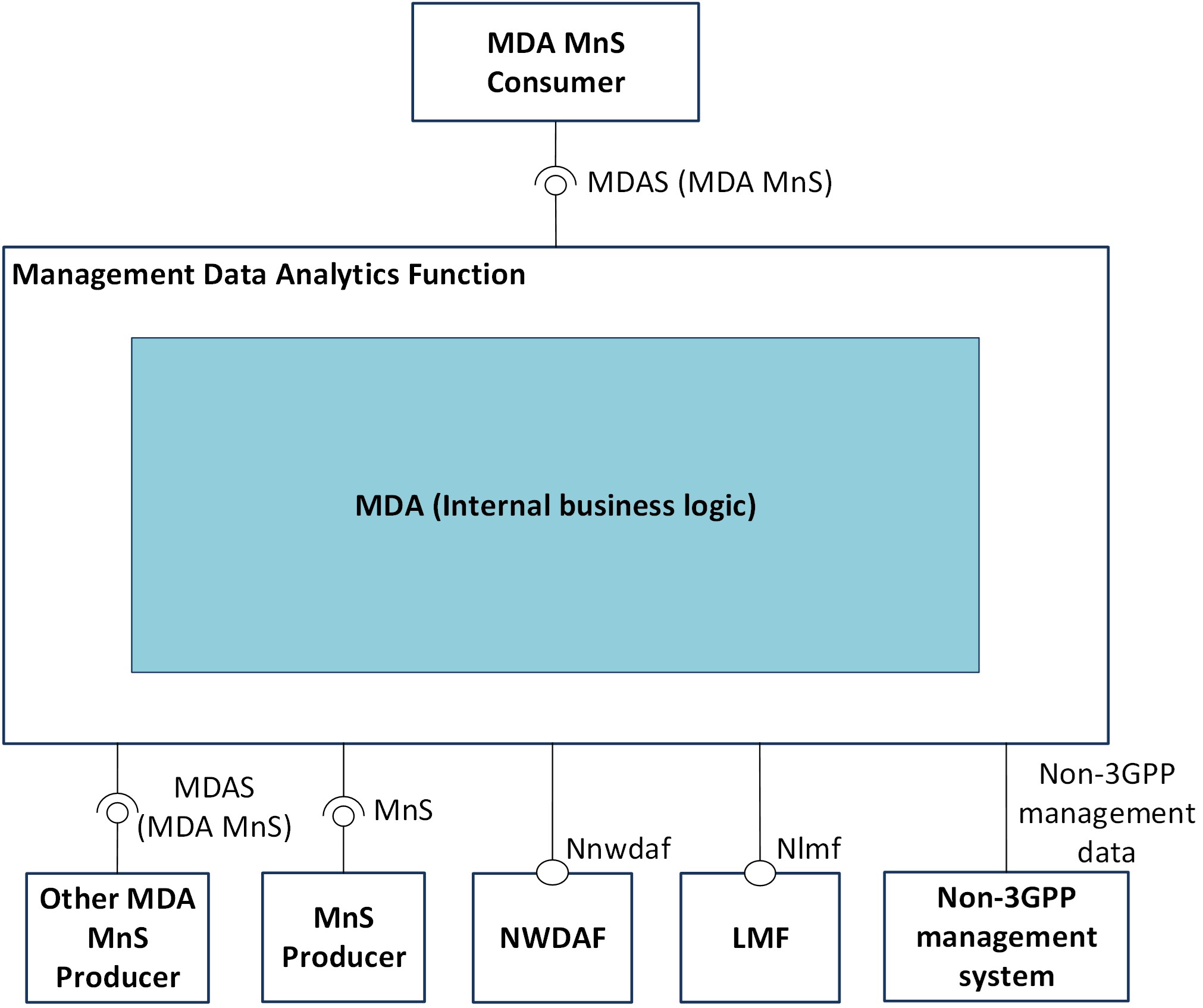
Figure 5: MDA functional overview and service framework
- The internal business logic related to MDA leverages the current & historical data related to:
- Performance Measurements (PM) as per TS 28.552 and Key Performance Indicators (KPIs) as per TS 28.554,
- Trace data, including MDT/RLF/RCEF, as per TS 32.422 and TS 32.423,
- QoE and service experience data as per TS 28.405 and TS 28.406,
- Analytics data offered by NWDAF as per TS 23.288 including 5GC data.
- Alarm information and notifications as per TS 28.532.
- CM information and notifications,
- UE location information provided by LMF as per TS 23.273.
- MDA reports from other MDA MnS producers,
- Management data from non-3GPP systems.
- Analytics output from the MDA internal business logic are made available by the Management Data Analytics Function (MDAF) playing the role of MDA MnS producer to the authorized consumers, (including but not limited to other management functions, network functions/entities, NWDAF, SON functions, optimization tools and human operators).
Rel-17 MDA supports a number of capabilities/use cases related to network slicing, as listed below:
- Coverage related analytics
- Slice coverage analysis
- SLS analysis
- Network slice throughput analysis
- Network slice traffic prediction
- Network slice load analysis
The MDA capabilities may also support analytics of a specific set of data or analytics for certain PMs, KPIs, trace data, QoE or other type of data.
The MDA capabilities are specified, each with the corresponding required minimum set of specific analytics inputs along with the expected analytics output information elements. The MDA MnS consumer can request the MDA MnS producer to provide MDA output for a list of specified MDA type of analytics, i.e., MDA type, which corresponds to an MDA capability, that supports analytics for a set of data or analytics for a certain PM, KPI, trace or QoE data. Following a successful MDA request any authorized MDA MnS consumer can obtain management data analytics from the corresponding MDA MnS producer. The MDA MnS consumer can control the MDA output by modifying the attributes related to the MDA request at any point in time including e.g. method of reporting. MDA output represented by the MDA report can be reported by file, streaming and notification.
Closed loop communication services assurance using network slices (TS 28.535 / 28.536)
Communication services using network slices can be assured through the capability provided by assurance closed control loops (ACCLs). The use cases, requirements, concepts, and background are specified in TS 28.535 and the solutions are specified in TS 28.536.
In a closed control loop, there is no direct involvement of a human operator or other management entity in the control loop, the control loop is fully automated. As shown in Figure 6 the human operator or management entity is not directly controlling the details inside the process steps but provides control outside the loop. For example, configuring goals for the control loop to make autonomous decisions within the boundaries of the set goal. Once the control loop is configured with the goal, the controlled entity is adjusted according to the set goals.
In a closed control loop the input to the control loop provided by human operator or other management entity may include the goal or policies. The output of the closed control loop may include closed control loop status to a human operator or other management entity.
Typically, the goal is set within certain parameter boundaries, and the closed control loop can automatically adjust the output based on the input within the parameter boundaries. Once a control loop cannot automatically adjust, the human operator or other management entity needs to be informed. The human operator or other management entity may decide to change the management of closed control loop so that it becomes an open control loop, where decisions are made by the human operator or other management entity and not by the closed control loop.
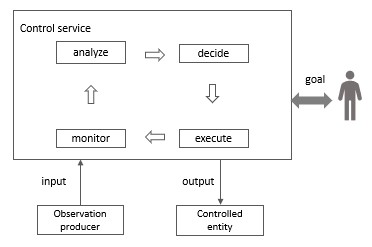
Figure 6: Closed control loop entities
The input to the closed control loop is the data concerning the resources used by the communication service and the corresponding service KPIs which are monitored by the closed control loop and step "Monitor". The input is analyzed by the closed control loop step “Analyze”, a decision on potential solution is provided by the closed control loop step "Decide" and the decision may be a possible action for the closed control loop step "Execute". The role of the decision support services is to provide variable degrees of automated decision making and human oversight support. The following two examples demonstrate how a closed control loop can be used:
- when a service experience degradation is detected (for example due to resource shortage or faults in the network), the resources used by a communication service may be adjusted automatically to improve the service experience
- the data associated with the communication service is monitored by the management services for data collection, this management service provides information to an assurance root cause analysis management service (example of an analytics service) and based on that information the assurance root cause analysis takes place, followed by proposing activities, mitigation or suggestions to solve the problem. The proposed activities, for example mitigation or problem-solving suggestion(s) are executed through provisioning services to bring the behaviour of the communication service within the requested boundaries of the metrics (SLS goals) that are controlled by the closed control loop.
The management services available for the closed control loop steps for "Monitor", "Analyze" and "Decide" are based on file transfer described in TS 28.550, or data streaming described in TS 28.550 and notifications described in TS 28.545.
The information provided from the "Monitor" step to the "Analyze" step includes performance measurements (see TS 28.552), KPIs (see TS 28.554), performance threshold monitoring events and fault supervision events (see TS 28.532).
For each ACCL the lifecycle is tracked, the lifecycle stage can be one of the following: preparation, commissioning, operation, or decommissioning. The operator sets the goal(s) for an ACCL using the service profile or slice profile attributes as input and when the ACCL is in operation, monitors corresponding observed or predicted goal fulfilment information. A goal may optionally include an assurance scope in terms of location and the operator may set a disallowed list to descope an ACCL.
Management of Non-public networks using network slices (TS 28.557)
A non-public network is a network that is intended for non-public use. Deployments of non-public networks in private environments (e.g. factories, enterprises) to provide coverage within a specific geographic area for non-public use is a key demand of emerging 5G applications and verticals (see TS 28.557).
An NPN (Non-Public Network) represents a 5G network with a delimited scope in its use (i.e. non-public use). This means that NPN management can be built upon the roles related to 5G networks management , as long as the scope of these roles is limited to acting on network and services for non-public use.
According to the above rationale, the roles related to NPN management mainly include:
- NPN Service Customer (NPN-SC): a Communication Service Customer (CSC) which consumes communication services for non-public use, i.e. communication services offered over NPNs. An NPN-SC is the realization of the CSC role (see definition in TS 28.530, clause 4.8) in NPN environments.
- NPN Service Provider (NPN-SP): a Communication Service Provider (CSP) which provides communication services for non-public use, i.e. communication services offered over NPNs. An NPN-SP is the realization of the CSP role (see definition in TS 28.530, clause 4.8) in NPN environments.
- NPN Operator (NPN-OP): a Network Operator (NOP) whose management scope is limited to 5G networks for non-public use, i.e. NPNs. An NPN operator is the realization of the NOP role (see definition in TS 28.530, clause 4.8) in NPN environments.
A mobile network operator (playing the role of NPN-SP) may decide to provision a PNI-NPN (Public Network Integrated NPN) for use by an enterprise (playing the role of NPN-SC) in the form of a network slice of a PLMN. This network slice may include PLMN network functions / network function services for non-public use. Depending on the NPN-SC, the slice can span one or more network domains, e.g.:
- Network slice corresponding to a RAN-only network slice subnet.
- Network slice corresponding to CN-only network slice subnet.
- Network slice corresponding to a network slice subnet composed of RAN slice subnet + Transport network slice subnet + CN slice subnet.
The NPN-SP maps SLS of requested PNI-NPN into ServiceProfile attributes. For details on these attributes, see TS 28.541. Based on these attributes, the NPN-SP determines to reuse an existing network slice or create a new network slice for the PNI-NPN. If an existing network slice can be reused, the operator may reconfigure the existing network slice.
Management support to Network Slice Security (TS 28.541)
Network Slice protection on N6 interface:
TS 22.101 defined Flexible Mobile Service Steering (FMSS) requirements to steer the subscriber’s traffic to appropriate enablers (e.g. NAT, antimalware, parental control, Firewall, DDoS protection) in the N6-LAN.
The implementation of the requirements in core network could improve the end user’s QoE, apply the security control, etc., for the 5G network. Further, service function chaining (SFC) requirements were defined in clause 6.35 of 22.261, which enables operator to define and modify service function chaining policies for steering traffic, create/modify/delete a service function, create/configure/control a chain of service functions, etc.
The requirements are for 5G network, which could be applicable to network slice as well to improve security of a network slice, especially at the N6 interface towards internet. In Release 17, Network Slice protection on N6 interface has been implemented for network slice security enhancement (cf. TS 28.541).
Network Slice specific authentication:
GSMA GST (NG.116 v4.0) defined Network Slice Specific Authentication and Authorization (NSSAA), which specifies whether for the network slice, devices need to be also authenticated and authorized by a AAA server using additional credentials different than the ones used for the primary authentication. In Release 17, Network Slice specific authentication has been added as first step to add the indication whether the network slice is subject to NSSAA (cf. TS 28.541).
Energy Services and Operations for Energy Utilities (TR 28.829)
The Energy service and operations for Energy Utilities study in Rel-18 is targeted to improve the support for a particular and important telecommunications service customer. Requirements for support of energy utilities (a 'vertical industry' from a 3GPP perspective) were added for Rel-19 in TS 22.261. These additions included specific requirements for manageability of 3GPP service to achieve increased availability and robustness for the energy utility operator by means of exposed monitoring information from the 5G system, specifically associated with the network slice providing services to the energy utility customer.
These requirements have led to a telecom management (SA5) study in Rel-18 with three objectives. The first objective is to report relevant network slice performance information from the mobile network operator to the energy utility operator, so the energy utility operator can respond to performance degradations proactively. The second objective is to develop a means for an energy utility operator to report performance degradations and incidents to aid in efficient incident response and root problem analysis for the energy utility operator. The third objective is to share local network outage information from the energy utility operator to the mobile network operator and to improve the possibility of smart energy services being employed for rapid recovery of both energy distribution and mobile network services (as these depend on energy services.) Together, this functionality will effectively improve the availability of mobile telecommunication services significantly, from the perspective of the energy utility operator, which is important as energy service itself must be extremely reliable.
Intent-driven management for network slicing (TR 28.836)
The Intent-driven management for network slicing study in Rel-18 is targeted to answer the question whether a complete alternative network slice management solution, built using the framework for Intent driven management services for mobile networks in TS 28.312 as base (see clause 4.5), is practically feasible and evaluate the advantages/disadvantages for such an approach. The scope for the study is to specify potential use cases, requirements and solutions for intent driven management for network slicing. Furthermore, it is the intention for the TR 28.836 to provide conclusions and recommendations on the next steps in the standardization.
Network slice management capability exposure (TR 28.824)
The network slice management capability exposure study in Rel-18 is targeted to improve the support of network slice management capability exposure toward the external customer who is outside the 3GPP management system, so that the external customer can use the Network slice management capability more efficiently. The study covers the topics such as what MnS, under what condition is suitable to expose to what types of MnS consumers (e.g. verticals and service providers). In addition, how to expose those MnSs in a flexible way that can fulfil the requirement is also considered.
TR 28.824 studies the concepts and roles related to network slice management capability exposure, as well as the procedure related to consumption of exposed network slice management capabilities. Based on the studied use cases, TR 28.824 is also investigating the possibility to expose network slice management capabilities via CAPIF, such as supporting external customer to discover the MnS using CAPIF API, conducting authentication and authorization with the related entities of CAPIF and consume the exposed MnS via CAPIF interface. In summary, this study is about the exposure capability and the interfaces that can implement the exposure capability, which is expected to improve efficiency of network slice management capability exposure towards the external customers.
References: List of TR, TS, study items and work items related to network Slicing
TRs and TSs related to network slicing:
|
Study on management and orchestration of network slicing for next generation network |
|
|
Study on tenancy concept in 5G networks and network slice management |
|
|
Study on management aspects of communication services |
|
|
Study on enhancement of management data analytics |
|
|
Study on Network Slice Management Enhancement |
|
|
Study on network slice management capability exposure |
|
|
Study on network and service operations for energy utilities |
|
|
Study on intent-driven management for network slicing |
|
|
Management and orchestration; Management Data Analytics (MDA) |
|
|
Management and orchestration; Concepts, use cases and requirements |
|
|
Management and orchestration; Provisioning |
|
|
Management and orchestration; Generic management services |
|
|
Management and orchestration; Architecture framework |
|
|
Management and orchestration; Management services for communication service assurance; Requirements |
|
|
Management and orchestration; Management services for communication service assurance; Stage 2 and stage 3 |
|
|
Management and orchestration; 5G Network Resource Model (NRM); Stage 1 |
|
|
Management and orchestration; 5G Network Resource Model (NRM); Stage 2 and stage 3 |
|
|
Management and orchestration; Fault Supervision (FS) |
|
|
Management and orchestration; Performance assurance |
|
|
Management and orchestration; 5G performance measurements |
|
|
Management and orchestration; 5G end to end Key Performance Indicators (KPI) |
|
|
Management and orchestration; Management of Non-Public Networks (NPN); Stage 1 and stage 2 |
Rel-15 Study / Work Items related to network slicing:
|
Management and orchestration of 5G networks and network slicing |
|
|
General aspects of NETSLICE |
|
|
Study on management and orchestration of network slicing for next generation network |
|
|
Provisioning of network slicing for 5G networks and services |
|
|
Network Resource Model (NRM) for 5G networks and network slicing |
|
|
Performance Assurance for 5G networks including network slicing |
|
|
Management and virtualization aspects of 5G networks |
|
|
5G Trace management |
|
|
Fault Supervision for 5G networks and network slicing |
Rel-16 Study / Work Items related to network slicing: (Search tip: '3gpp SP-190786' etc.)
|
Enhancement of 3GPP management system for multiple tenant environment support |
SP-190786 |
|
Management Aspects of 5G Service-Level Agreement |
SP-200185 |
|
Closed loop SLS Assurance |
SP-190781 |
|
Enhancement of performance assurance for 5G networks including network slicing |
SP-190247 |
|
Overall aspects of 5G_SLICE_ePA |
SP-190247 |
|
KPI reporting |
SP-190881 |
|
Study on management aspects of communication services |
SP-180923 |
Rel-17 Study / Work Items related to network slicing:
|
Management of non-public networks (NPN) |
SP-200189 |
|
Management of the enhanced tenant concept |
SP-220293 |
|
Enhancements on EE for 5G networks |
SP-200188 |
|
Enhancements of Management Data Analytics Service |
SP-210132 |
|
Enhanced Closed loop SLS Assurance |
SP-200196 |
|
Enhancements of 5G performance measurements and KPIs |
SP-200462 |
|
Enhancement on Management Aspects of 5G Service-Level Agreement |
SP-210860 |
|
Study on network slice management enhancement |
SP-200766 |
Rel-18 Study / Work Items related to network slicing:
|
Network slice provisioning enhancement |
SP-211434 |
|
Network slicing provisioning rules |
SP-211449 |
|
Study on intent-driven management for network slicing |
SP-220278 |
|
Study on network slice management capability exposure |
SP-220350 |
|
Study on enhancement of management of non-public networks |
SP-211436 |
|
Study on Network and Service Operations for Energy Utilities |
SP-211622 |


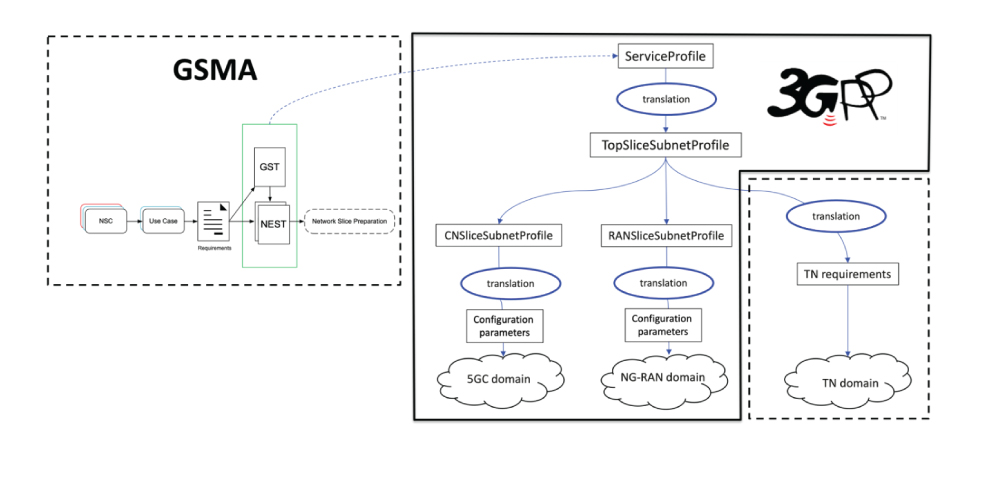

 Technology
Technology
